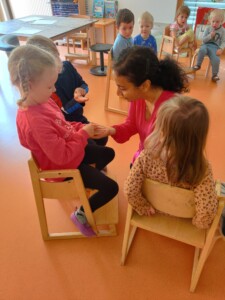In March 2022 a book project started in the Kinderhaus Energiebündel. The pedagogue chose the book „The hungry caterpillar“ – written by Eric Carle. It was important for the pedagogues to use the immersion method which was implemented through-out the project. During the project the children were “surrounded” constantly by English. Dilan Alkan used the Kamishibai to introduce the story in German, and Mahfuza Hossain used the big book version to read the story in English. One of the pedagogues also prepared fruit prop cards for the children in the respective sequence as the book – for example one apple, two strawberries and so on. By repeating frequently, the children learned the English names e.g. for the different food items in the book.
The project takes place once a week. We start with the story telling session and a sing-along activity of the song „Fuzzy Wuzzy Caterpillar“. Then a crafting activity is offered to visualize the story, the characters and all the elements in the book. All the elements and characters which the children have crafted or the ones they will craft in future will be put in boxes. So, the children have a “story box” with which they can tell the story of the hungry caterpillar themselves. They might even tell the story partly in English.
The children are challenged to use all their senses: they listen, talk and ask questions about the story. They use their imagination and their creativity to craft their own caterpillars, butterflies and different fruit props. They use their motor skills to craft as well as inspiring and supporting each other. At the same time, they are immersed in the English language and by now they all know exactly what a caterpillar, a butterfly, an egg, the moon, a cocoon, a leaf, the days of the week are in English.
„Die Raupe Nimmersatt“ – ein Buchprojekt
Im März 2022 begann im Kinderhaus Energiebündel ein Buchprojekt zur „Raupe Nimmersatt“, geschrieben von Eric Carle. Ein Ziel der Pädagoginnen war, gezielt die Immersionsmethode während des gesamten Projekts anzuwenden und die Kinder stärker in die englische Sprache „einzuhüllen“. Dilan Alkan nutzte das Kamishibai, um die Geschichte auf Deutsch vorzustellen. Mahfuza Hossain nutze die große Buchversion der „Raupe Nimmersatt“, um die Geschichte auf Englisch zu lesen. Für die Kinder hatte eine der Pädagoginnen Karten vorbereitet, z.B. mit einem Apfel oder zwei Erdbeeren usw. Das Ziel war es, den Kindern zu zeigen, wie z.B. die Lebensmittel auf Englisch heißen, und sie in die Lage zu versetzen, diese zu identifizieren und zum Teil zu benennen – auch auf Englisch. Das Projekt findet jede Woche statt. Wir beginnen mit dem gemeinsamen Erzählen der Geschichte und dem Singen des Liedes „Fuzzy Wuzzy Caterpillar“. Anschließend basteln die Kinder die verschiedenen Charaktere und Elemente aus dem Buch, wie z.B. die Raupe, den Schmetterling oder Lebensmittel. Die selbst gebastelten Elemente kamen und kommen in einen Schuhkarton, der als „Erzählkiste“ fungiert. Mit ihrem Karton kann jedes Kind die Geschichte der Raupe Nimmersatt selbst erzählen. Vielleicht nutzen sie dabei auch englische Wörter.
Im Rahmen des Projekts nutzen die Kinder viele ihrer Kompetenzen und haben die Möglichkeit diese weiterzuentwickeln. Sie hören zu, sprechen miteinander und stellen Fragen. Sie nutzen ihre Fantasie und ihre Kreativität. Sie nutzen ihre motorischen Fähigkeiten, um zu basteln. Sie erzählen die Geschichte und entwickeln dabei aktiv ihre sprachlichen Kompetenzen. Und all das, während sie eingehüllt sind in die englische Sprache. Inzwischen wissen sie alle genau, was eine Raupe, ein Schmetterling, ein Ei, der Mond, ein Kokon, ein Blatt und die Wochentage auf Englisch sind.
Von Mahfuza Hossain, element-i Kinderhaus Energiebündel




